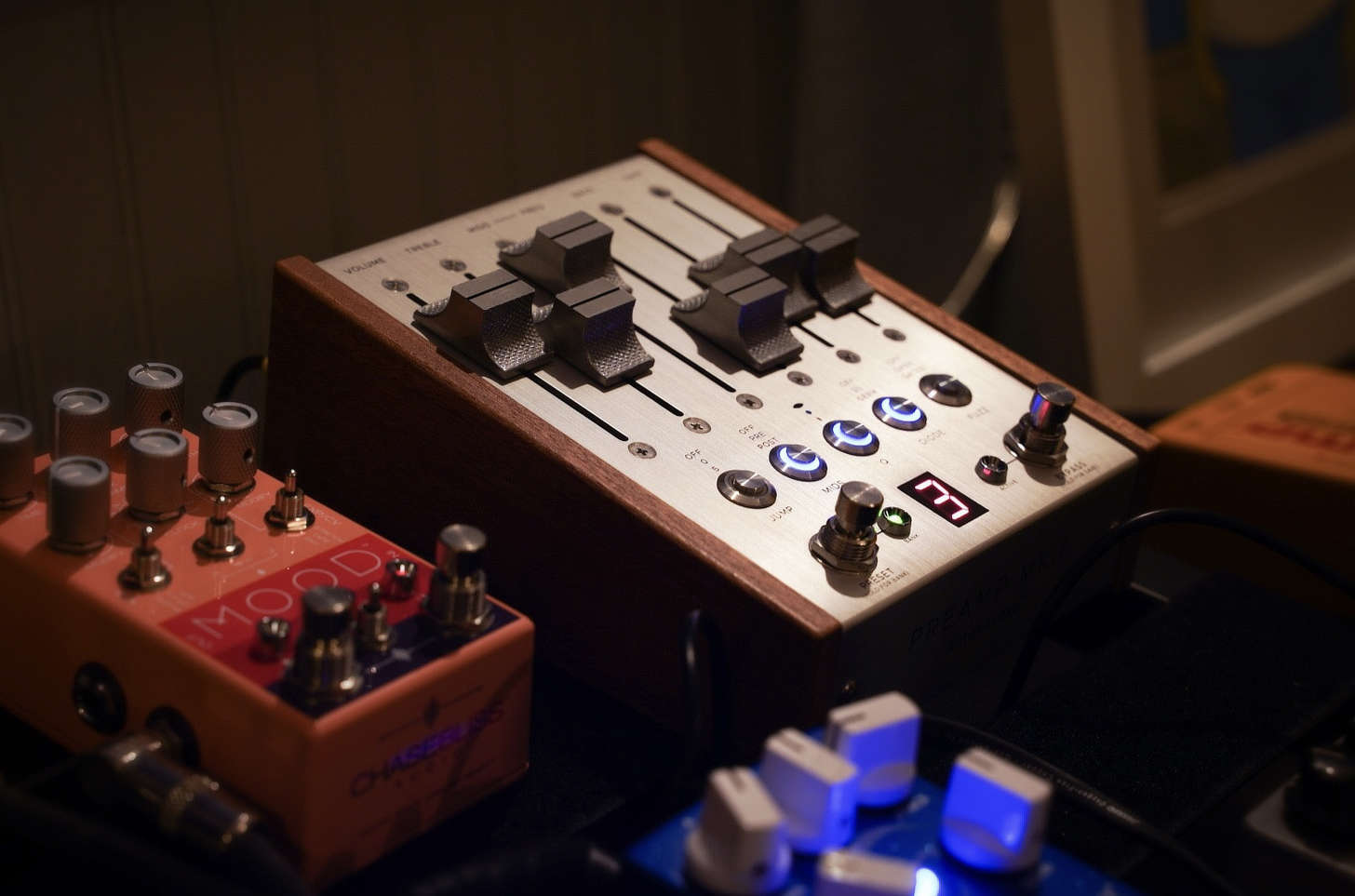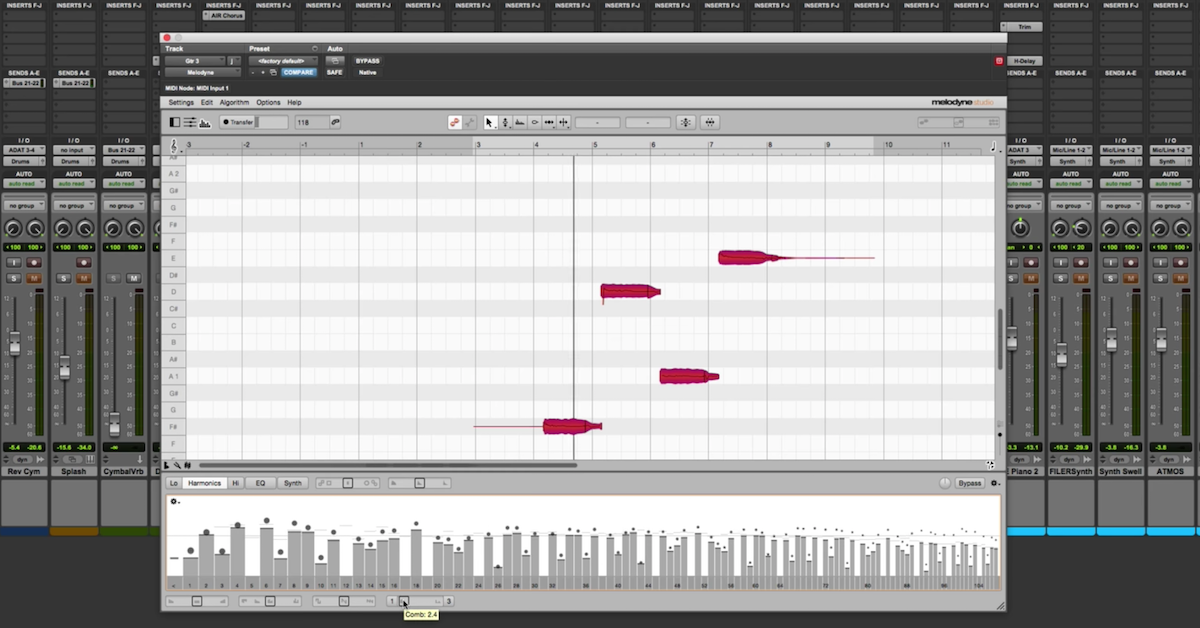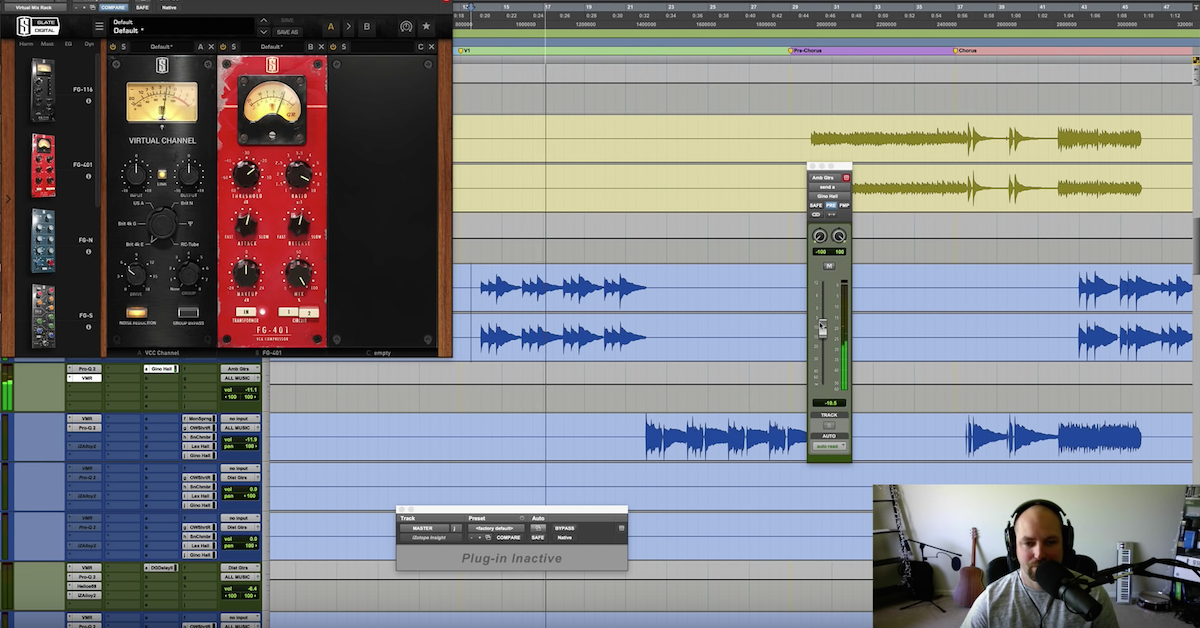7 Tips for Mixing Electric Guitar
Article Content
Being that electric guitar is my primary instrument, I have a unique relationship with it when it comes time to mix. You never want to give any individual instrument preferential treatment when mixing. But since I’ve been playing guitar for over 20 years, I can’t help but feel a sense of primal nostalgia when working on productions that prominently feature the instrument. I may tend to nitpick electric guitars more than other instruments, but never at the expense of the overall feeling of the performance.
What I find so interesting about electric guitars (and what can present a challenge when recording and mixing them) is that a stunningly wide variety of sounds can be achieved with them. While they have become a staple of popular music since their invention by musician George Beauchamp in the 1930s, the sounds achieved with them (and subsequently heard on our favorite records) have been anything but consistent. From the fuzzy power chords of “You Really Got Me” by The Kinks (which was apparently achieved by slicing the speaker cone of an amplifier with a razor blade), to the screaming overtones of Queen guitarist Brian May’s homemade “Red Special” guitar (which was built in part using a fireplace mantle), to the gorgeously delayed (and expensive) chime of U2’s The Edge, it’s actually kind of hard to believe that each of these tones were achieved using the same instrument. This is, in part, due to differences in writing and performance but also because of differing amplifiers, pedals, outboard gear and recording techniques. While I recommend getting the desired sound dialed in when tracking, you can make (or break) the electric guitar when it comes time to mix.
In this article, I’ll be sharing some of my favorite tools and techniques when mixing electric guitars.
1. Context, Context, Context
As with every individual part of an arrangement, it’s crucial to determine what kind of role the electric guitar is going to play in the grand scheme of things. Obviously, your approach is going to be different on a guitar-driven, thrashy metal record than it would be on a ballad that only features the instrument in a supporting role and only during certain sections of the song. I advise any mix engineer to engage in a discussion with their client as to how to interpret the instrument, and perhaps ask for reference tracks so that you can really achieve what is desired. As mentioned, there are a seemingly infinite number of sonic directions you can go when mixing electric guitars — way more than, say, a grand piano. For as beautiful and regal as a grand piano is, I can’t think of more than 2-3 songs I’ve mixed in my entire career that called for me to make one sound like anything but, well, a standard grand piano. Figure out which exact direction you want to go with the more malleable guitars early on.
2. What Are You Working With?
Here’s a quick but important tip — you can get a great guitar sound by sticking a Shure SM57 in front of an amp, but it’s common practice to use multiple microphones when recording. Some common amp recording techniques include placing microphones off-axis, miked from behind, further off the amp and more. The recording engineer should have worked to get proper phase and polarity, but it never hurts to check these and correct any inconsistencies.
Also, if you’ve been provided multiple mics, even a slight change in the level of either microphone can change the overall tone drastically. You can alter the balance of individual tracks as a sort of alternative to equalization.
In the event that I’m given multiple mics on the same performance, I may bounce these tracks down to one, or at the very least send them through their own auxiliary group so that I can treat them as one.
3. Panning is Essential
Distorted electric rhythm guitars generally aren’t very dynamic and tend to take up lots of space frequency-wise. If you filter out or attenuate too much low end, they’ll sound weak and lifeless. If you do the same in the high frequencies, they’ll lack in “crunch” which is part of what we enjoy about distortion anyway. To complicate things further, in lots of rock and punk music electric guitars are commonly doubled, if not layered even more. Because of this, they tend to eat up lots of sonic real estate.
Use panning, and don’t be afraid to pan doubled guitars as wide as they can possibly go. This will help prevent the guitars from masking your vocals, drums, bass, etc. I might even send my electric guitars to their own stereo buss and use a bit of stereo widening to further push them to the sides. The iZotope Imager is fantastic for subtle to moderate stereo imaging applications. Be warned, a little bit of widening can go a long way, and this effect is easy to overdo. Also, consider my previous point about the particulars of multiple mics — if I’ve got individual Shure SM57 and Royer 121 tracks, they will most likely be panned together exactly.
If you’re working on a production that has a singular “noodly” electric guitar part, you might want to keep it a little closer to the center, perhaps panned as equidistant from the center as a synthesizer, horns or any instrument that shares a similar timbre as electric guitar. I generally place guitar solos straight up the middle unless they’ve been double-tracked, or if the melody has been doubled on a different instrument.
4. How to Incorporate Compression
Dynamic range compression can actually do quite a lot for clean or semi-clean electric guitars by greatly altering the pick attack and sustain of chords & individual notes. On distorted guitars however, compression has much less of a pronounced effect. Heavily distorted guitars don’t have that much dynamic range anyway, so don’t expect to be able to work wonders with your favorite compressor when trying to carve out space for other elements. You may, however, benefit from side-chain compression — use the signal from a vocal, kick or snare to trigger compression on an individual electric guitar track (or buss), essentially ducking the guitars so that those other elements aren’t masked.
While I wouldn’t consider multi-band compression one of my most commonly used fixes for masking duties, I may apply a multi-band compressor on electric guitars. First, I find the frequency range(s) of the vocals and snare, and then I use anywhere from 1-4 dB of gain reduction in those ranges to clear out space for the latter mentioned tracks to be heard.
An 1176-style compressor is effective on clean or overdriven guitars that could stand to benefit from harmonic saturation. The UAD Distressor is great for more aggressive gain reduction duties.
5. EQ Duties
As I mentioned, one of the more common problems I run into when mixing electric guitars is how much space they take up relative to other elements. But much can be accomplished using subtractive equalization. Of course, sometimes there will be situations in which guitars need additive EQ to allow them to reach their full potential and really cut through in a mix. The information between 500 Hz and 6 kHz is essential for the fidelity of the instrument, and I’ll often use a surgical EQ such as the FabFilter Pro-Q 3 to both remove unwanted resonances and boost in areas that are lacking.
In addition to the aforementioned FabFilter Pro-Q 3, I love applying a mid-forward equalizer such as the UAD API Vision Channel Strip for more broad stroke EQ duties.
6. Reamp and Incorporate Pedals
If at all possible, I recommend obtaining direct inject (DI) guitar recordings. This allows for maximum flexibility when mixing. One of the most fun ways to give electric guitars my own sonic signature (when it’s needed) is to bring them out of the box and run them through my combination of amplifiers and pedals — a process known as “reamping.”
I accomplish this by sending signal out of my Universal Audio Apollo x8, into a Radial Engineering X-Amp active reamp device and then into whatever signal chain I desire before re-recording the altered signal back into my DAW.
Sometimes I’ll simply go into my Fender Princeton and/or Vox AC30 amplifiers before miking them up. Other times I’ll only use the variety of effects found on my pedalboard. Sometimes I’ll incorporate both the amps and pedals — it all depends what kind of mood I’m in, how much time I feel like spending on tweaking things and what sonic flavors the song needs.
One of the most groundbreaking pedal companies I discovered recently is Chase Bliss Audio, a Minnesota-based company who offer an impressive line of effects units that sport highly configurable digital features, alongside the warmth and wonder of analog sound.
When my reamped guitar tracks need overdrive and/or fuzz, I’ve been having endless fun with the Preamp MKII Automatone, which might be the finest overdrive unit that I’ve ever used. The Automatone features a superb-sounding Benson Preamp, with transistor, silicon and germanium diode settings, as well as treble, mid and bass tone controls. The mids can be further dialed in thanks to a parametric control that ranges from roughly 150 Hz to approximately 4 kHz.

Reamping with the Chase Bliss Preamp MKII and MOOD Pedals
This glorious unit also features the ability to save presets, and the faders will actually jump to the saved position upon choosing a preset — it truly needs to be seen (and heard) to be believed. For anyone wondering if it’s worth the asking price, I firmly believe that this unit can replace most or all other overdrive/fuzz pedals on your board.
Sound Clips (Example 1)
^ Rhythm Guitars Recorded Directly Into the DAW ^
^ Rhythm Guitars Reamped Through the Chase Bliss Preamp MKII and my Vox and Fender Amps ^
^ Lead Guitar Recorded Directly Into the DAW ^
^ Lead Guitar Reamped Through The Chase Bliss Preamp MKII and a Variety of Plugin Effects ^
^ Full Mix Featuring Drums, Bass, and Reamped Guitars ^
Sound Clips (Example 2). Thanks to my friend and colleague Jason Cummings for providing this rocking tune
^ Rhythm Guitars Recorded Directly Into the DAW ^
^ Rhythm Guitars Reamped Through the Chase Bliss Preamp MKII and my Vox and Fender Amps ^
^ Full Mix Featuring Drums, Bass, and Reamped Guitars ^
Another pedal unit from Chase Bliss that I use, albeit for a much different application, is the Mood. It’s a self-described “micro looper and delay with whimsy.” Mood allows me to completely re-imagine elements from a mix, and not just electric guitars. I can create complex, dazzling ambiences from a small snippet of audio, entirely alter the pitch and time of individual elements or make aggressively noisy loops that sound nothing like the original source material whatsoever. This pedal is just as much about the process as it is the final result, so make sure you’ve got substantial time budgeted to spend with it to fully unleash its potential.
7. Don’t Hesitate to Transform Your Electric Guitar Recordings
Lastly, while sometimes the best course of action is to subtly enhance an electric guitar part so that it sounds like the best version of itself, don’t be afraid to mangle, warp, wash out and distort your guitars in creative ways if you think it’ll benefit the production. As was established early in this article, some of the most iconic guitar tones of all time are a result of drastically altering guitar signals using effects and non-traditional recording techniques.
The Soundtoys bundle is chock full of effects that can be used to mutate guitars — I’ll use Decapitator for blistering saturation, Echoboy for evolving feedback delay, Little Plate for a subtly modulating infinite reverb tail, and the Effects Rack if I feel like combining multiple effects.






